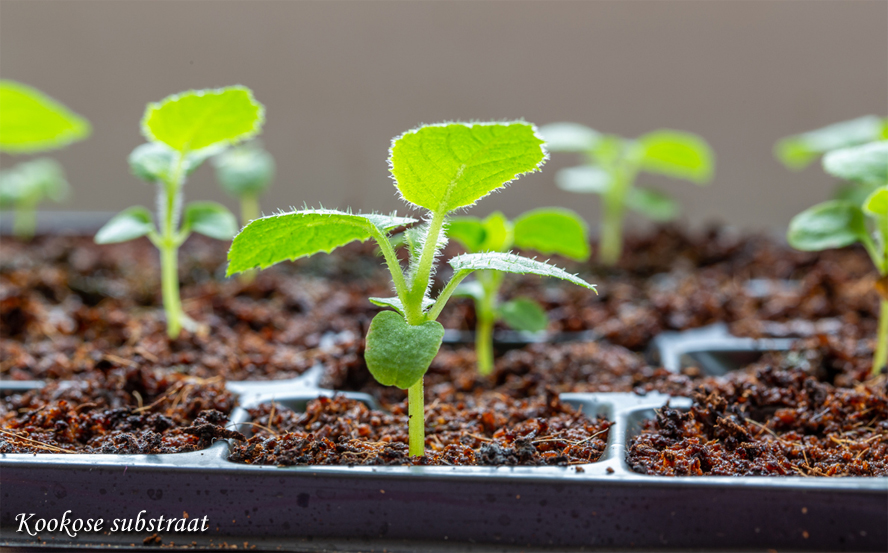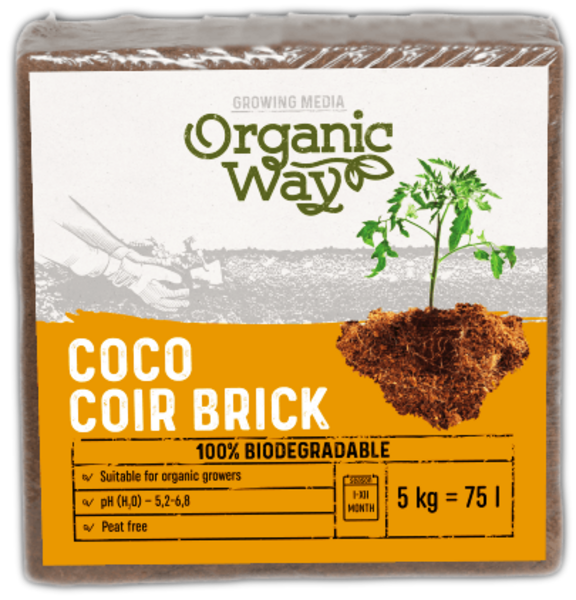(30cm x 11cm x 30cm).
5 kg of this coconut soil, when adding water, takes up a volume of about 75 liters.
This soil perfectly absorbs and retains moisture, and also allows the roots to breathe freely.
Main ingredients: 100% mechanically shredded coconut fiber.
Ingredients: 100% coconut husk.
How to use: place the briquette in a container, fill it with 20–25 liters of water and leave for about 30 minutes. Then add another 50-55 liters (to the desired consistency).
Stir before use.
Designed for sowing seeds, planting and replanting indoor plants, flowers, bulbous flowers.
Coconut fiber substrate can be used not only as a growing medium for plants, but also as litter for cats and reptiles, and as a substrate for growing earthworms, snails or mushrooms.
The finished substrate can be mixed in equal parts with garden soil and used for mulching plants and shrubs.

Its advantages:
* 100% natural, organic (made from coconut fiber).
* Does not contain fertilizers.
* Crumble and light structure.
* Facilitated oxygen absorption by plants.
* Faster development of the root system.
* Has no odor and does not rot.
* The pH of the substrate is optimal for the growth of most plants (ph 5.4 - 6.8).
* Significant water holding capacity (retains 7 times its weight in moisture).
Coconut substrate absorbs water immediately and retains moisture much longer than peat.
Remains moist even after the soil itself has dried.
* 100% free of pathogenic fungi, does not promote the growth of bacteria and fungi.
* Excellent ability to mix with soil, does not compress.
* Long period of use: up to 5 years, self-degrading material.
* Which is better: coconut or peat substrate?
If we compare it with the most common leavening agent among gardeners, peat, then coconut substrate has certain advantages.
Many gardeners are familiar with the situation with overdried peat: it takes a very long time and is difficult to soak it and make it suitable for use. The coconut substrate, being completely dried, becomes soaked within half an hour.
Yes, and small particles of peat have a “habit” over time, when watering, along with water, go down the planting hole or container, and coconut substrate has larger particles and fibers, which allows it to be evenly located in the root zone all the time. Therefore, seedlings grown in coconut substrate or a soil mixture with its addition have a better and more evenly grown root system (note how many manufacturers of planting material in containers use coconut substrate - it is easier to transport, and the roots develop better in it).
In what cases should you use coconut substrate?
In indoor floriculture.
There are two options for using coconut substrate for growing indoor or container plants: either grow in pure coconut substrate, but with constant and regular feeding, or make a mixture by adding soil and vermicompost to the substrate.
Sowing seeds for seedlings.
Since it is sterile, you will likely get rid of most problems with young seedlings (blackleg, insects and weeds).
But it’s worth keeping two things in mind: since the substrate itself is a fairly large fraction, it’s worth sowing large seeds into it. Pure coconut substrate itself has virtually no nutritional value, which means it either needs to be specially prepared for sowing seeds, or fertilized with liquid fertilizers after the first true leaf appears.
Growing seedlings after picking.
To do this, soaked coconut substrate is mixed in approximately equal parts with disinfected garden soil from your site. The soil mixture turns out to be both loose and nutritious, and the seedlings are accustomed to the characteristics of your soil from childhood.
Planting plants in open ground.
If you create a mixture of soil and coconut substrate (approximately 1:1) in the planting hole, then adaptation and growth of new roots will happen faster, which is very important at the initial stage of the plant’s life in open ground.
Mulching the soil.
Coconut substrate can be used as mulch and as insulation for the roots of young plants.
How to properly prepare coconut substrate?
The pressed block must be filled with water in the required quantities, as indicated in the instructions.
If you don’t need that much at once, you can cut off part of the block. True, it is difficult to do this with a knife; a saw or cutting power tool will do.
But you can improve the technology a little and soak the dry substrate not in clean water, but with the addition of a small amount (according to the instructions) of water-soluble complex mineral fertilizer, or even better with the addition of liquid vermicompost. This mixture will provide all your plants (except succulents) with everything they need: moisture, nutrients, and air.















